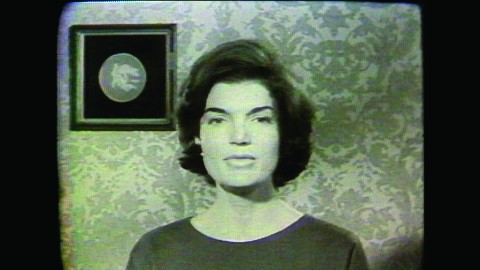Every election year since 1984, Antoni Muntadas and Marshall Reese have updated their anthology Political Advertisement. A selective compilation of political ads since 1952, the year they were first introduced, it shows the remarkable way in which TV and politics have become inextricably intertwined. Strung together without commentary or conspicuous editing, the sequential run of ads speak for themselves, providing “a key to understanding the evolution of images on television and the marketing of politics," as stated in the opening credits.
Long, scripted, and at times stilted, speeches would soon give way to theatrical enactments, followed by cartoons, songs, celebrity appearances, and even Spanish language spots from the then-innovative John F. Kennedy campaign. In the mid-1960s, there was an observable increase in candidates’ attempts to play on our emotions with dramatic portrayals aimed at instilling fear and anger in the viewer. The stakes grew exponentially and concerns for personal safety or danger came to the fore, as seen in the scare tactics—images of blood, weapons, and guns set to an ominous, paranoiac soundtrack—of Richard Nixon’s 1968 campaign. And then the attack ads appeared…and never went away. Instead, they intensified, as in the infamous “Willie Horton Ad” from 1988 created to support George H. W. Bush’s campaign.
The changes in candidates’ focus on topics over the years—from “kitchen table issues” of jobs, prices, and the economy to the devastation of war and fears of crime, drugs, and immigration—brought about increasingly inflammatory language attended by more sophisticated, dramatic techniques of representation. The form and content of political ads have joined together, and now seemingly are one. That is, special effects and graphics blend with patriotism, and the language of marketing or the “hard sell” of advertising permeates political rhetoric and discourse.
Viewing the ads from different political epochs together also illuminates characteristics and connections among them. Certain motifs return again and again, such as the politician's desk, the testimonial, stump speeches, shaking hands with crowds, and free time with the family. Figures and names also reemerge over the years—Reagan, Kennedy, Bush, and Clinton.
Other significant developments that appear in Political Advertisement have become the norm. By the 1980s, ads for primary candidates, not just the two nominees, appeared on TV, signaling the increase in money involved in campaigns to afford them. We also witness the rise of ads produced by political-action committees (PACs) and special-interest groups in the 2000s as an outgrowth of the 2010 Citizens United Supreme Court decision. “The amount of money dumped into the campaigns is staggering. It basically subsidizes the media and television,” Reese observed.
Remarkably, Political Advertisement X runs through the first thirty years of ads in approximately thirty minutes. Conversely, it takes twice the amount of time—over an hour—to show ads from the last forty years. And Muntadas notes, “citations and quotations from previous campaigns abound.” Rubio has remade Reagan, and Clinton has revisited LBJ. Ads even speak to each other, as in a 2000 John Kerry ad that responded with outrage to George W. Bush’s “Swift Boat Ad.” The political advertisement has become a genre with a seven-decade genealogy to which it now can refer.
Nonetheless, Political Advertisement is not only an archive; it also is a work of art. In fact, Reese has called it “the longest-running video art project in the world.” The backgrounds and perspectives of the New York–based artists therefore played a role in its assembly. Muntadas grew up in Spain under Francisco Franco, an experience that attuned him to the dangers of political propaganda. Marshall Reese hails from Washington, DC, where he watched political ads as a kid and now views them with nostalgia and even affection. Their opposing perspectives on the ads are echoed by the mixture of tones and styles in their selection of videos. On the one hand, some ads raise the stakes of the election in a hyperbolic manner, for instance, advising viewers to view their vote “like [their] whole world depended on it,” as Nixon urged in 1968. On the other hand, some of them appeal to our better angels with humor or wholesomeness. In either approach, Political Advertisement makes it clear that the presidency is now sold like a commercial product and television is its ideal medium. —Kanitra Fletcher

